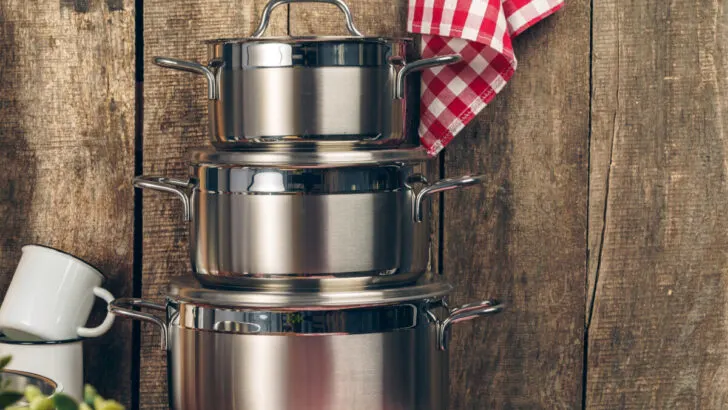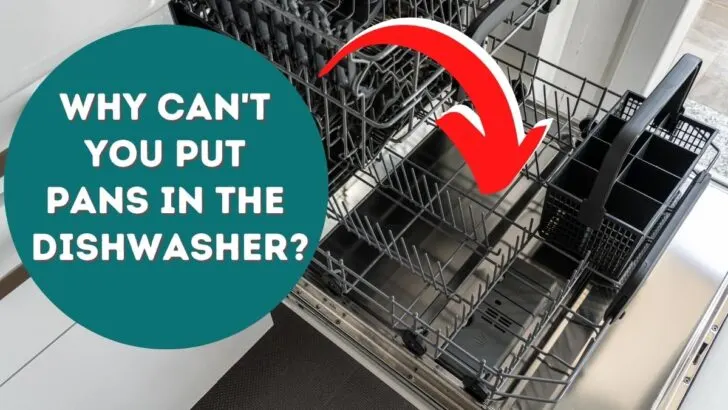Washing your cookware in the dishwasher can be so appealing, especially if you have to scrub sticky and greasy pans manually. However, the different materials and types of pans might raise the question of whether using your dishwasher to clean your cookware ruins your pans.
Pans made of cast iron, copper, and nonstick coating are not safe to put in the dishwasher due to their finishes. However, stainless steel and glass pans can withstand hot water and strong cleaning chemicals and can sometimes be put in the dishwasher. However, unless the manufacturer specifies otherwise, using the dishwasher to wash cookware is typically not a good idea.
Read on to learn more about what kind of pans you can and cannot put in the dishwasher.
Pans That Are Dishwasher Safe
Glass and stainless steel baking pans are usually claimed to be dishwasher safe. But still, the heat and harsh chemicals can harm their coatings.
Glass pans are recommended to be hand washed if you wish to keep them spotless, because the abrasive chemicals will dull the glass surface.
For other materials like cast iron, aluminum, and nonstick-coated cookware, most manufacturers highly advise hand cleaning to prevent damage.
Aluminium pans can occasionally be put in the dishwasher, although hand cleaning is generally advised. Alternating between handwashing and dishwashing for aluminium pans can be done since the cleaning agents included in dishwasher detergent may dull the pan's surface.
To be sure, it is better to look for a scratch or marks on the pan itself after dishwashing. The pans should also be placed apart from other dishes and utensils in the dishwasher as this material is often scratched easily.
Lastly, never place pans made of ceramic, cast iron, or those coated with a nonstick surface in the dishwasher, as they will become useless and damaged after some washes.
How To Hand Wash Pans That Cannot Be Dishwashed?
The safest method of cleaning most pans is to simply use dish soap, warm water, and a sponge. Except for cast iron, soaking any pan for around 20 minutes will help soften tough-to-clean places if there are still some food particles clinging on. To prevent rust, make sure to promptly dry the pans.
Here are some recommendations for different kinds of pans:
Stainless steel: Using a typical kitchen sponge and hot, soapy water in the sink, you should be able to clean stainless steel pans. Using a paper towel and a few drops of olive oil, rub the area until the food particles fall off in case when the stubborn food particles won’t budge.

Aluminum: A straightforward soap and water bath is excellent for aluminum pans. For stubborn stains, use fine-grade steel wool or a green sponge and employ a back-and-forth motion rather than a circular motion to prevent damage.
Nonstick coating: Pans with nonstick coatings have to be handled carefully since the coating is prone to scratches. It is advised not to use any abrasives on the nonstick surface of these pans and wash them one at a time in the sink.
Copper: Since copper has glossy surfaces that are readily scratched, it should be hand cleaned as usual without using abrasives. If discoloration starts appearing, mix 1/4 cup white vinegar and 2 teaspoons salt. To brighten the metal, use the soft side of a sponge to gently rub the solution onto the surface of the copper.
Cast iron: Avoid soaking these pans, as cast iron rusts fast when left to sit in water. Cast iron is porous, therefore using soap on it will cause it to lose the seasoning it has developed. Use a hard brush, plastic scrubby, or green sponge to remove food particles from cast iron to prevent damage.
Steel wool can be used only when attempting to remove rust from a pan. Simply add hot water, scrub well, and rinse often. Before applying a small coating of oil, make sure your cast iron is completely dry by heating it on the stove or by hand with a towel.
How Can You Tell If a Pan is Safe For the Dishwasher?
Usually, the handle of cooktop pans has an inscription stating whether or not they may be washed in the dishwasher. If not there, it could be found on the pan’s bottom.
Different manufacturers use different symbols to indicate whether pans and other items may be washed in the dishwasher. Typically, there will be a square with a simple illustration of dishes such as plates, cutlery, or glasses and a mark denoting water-like droplets or dashed lines.
While some manufacturers simply state “dishwasher safe,” others are more precise and direct you to put the pan on the top or bottom rack.
When your cookware doesn’t have obvious indicators, common sense can help. The high temperature of the dishwasher will harm pans with any type of coating, such as nonstick, and render them dangerous to use.
Many manufacturers include cleaning instructions on their product websites if you’re still not sure if your pan should go in the dishwasher or not. You should be able to get the solution if you simply search for the pan’s brand or maybe look here.
Final Words on Putting Pans in the Dishwasher
To sum it up, pans made of stainless steel and glass are generally dishwasher safe, whereas pans made of any other material may get dull or ruined to the point it becomes useless over time if you put them in the dishwasher.
To make sure your pan is dishwasher safe, check for an inscription from the manufacturer itself or search on the company’s website whether they claim their pans to be dishwasher safe. Regardless, manually washing pans made with any material is still the best way.


